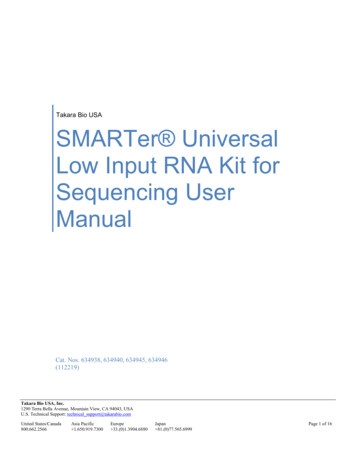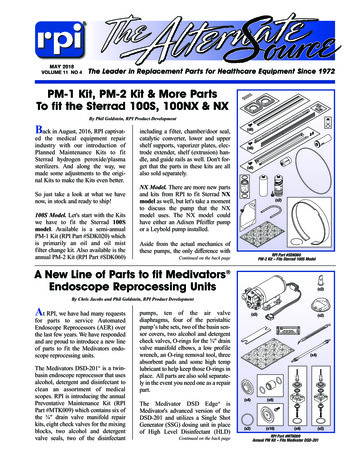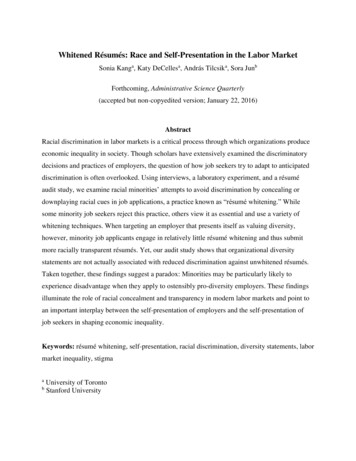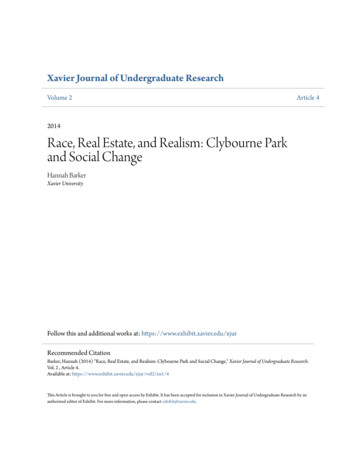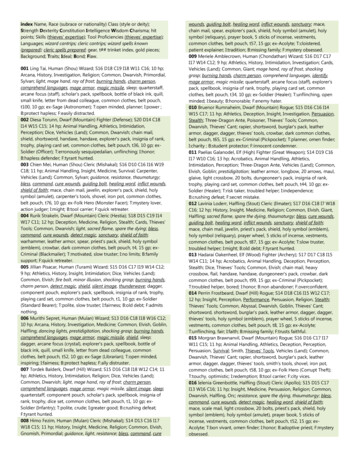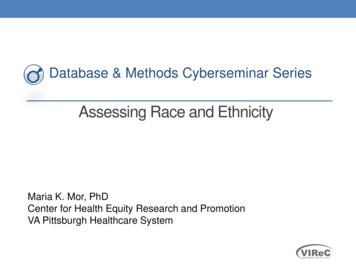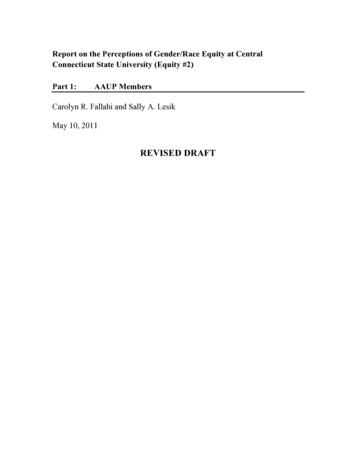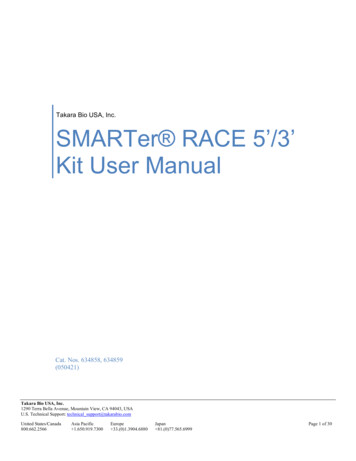
Transcription
Takara Bio USA, Inc.SMARTer RACE 5’/3’Kit User ManualCat. Nos. 634858, 634859(050421)Takara Bio USA, Inc.1290 Terra Bella Avenue, Mountain View, CA 94043, USAU.S. Technical Support: technical support@takarabio.comUnited States/Canada800.662.2566Asia Pacific 1.650.919.7300Europe 33.(0)1.3904.6880Japan 81.(0)77.565.6999Page 1 of 30
SMARTer RACE 5’/3’ Kit User ManualTable of ContentsI.Introduction . 4II.List of Components . 7III.Additional Materials Required . 8IV.Primer Design . 9A.Primer Sequence. 9B.Additional Considerations for Design .10C.Location of Primer Sequences within Genes .10D.Nested Primers .10V.Generating RACE-Ready cDNA .11A.General Considerations.11B.Preparation and Handling of Total and Poly A RNA.11C.Assessing RNA Template Quality .12D.Protocol: First-Strand cDNA Synthesis .13VI.Rapid Amplification of cDNA Ends (RACE).15A.Things You Should Know Before Starting RACE PCR Reactions.15B.Protocol: Rapid Amplification of cDNA Ends (RACE) .15VII.Characterization of RACE Products.17A.Protocol: Gel Extraction with the NuceloSpin Gel and PCR Clean-Up Kit .17B.Protocol: In-Fusion Cloning of RACE Products .18C.Sequencing RACE Products .19VIII.References.20Appendix A. Troubleshooting Guide .21A.Troubleshooting Touchdown PCR .21B.Multiple Band RACE Products .23C.Other Specific Problems .25Appendix B. Detailed Flow Chart of 5’ RACE .27Appendix C. Detailed Flow Chart of 3’ RACE .28Appendix D. 5’-RACE cDNA Amplification with Random Primers .29A.Protocol: First-Strand cDNA Synthesis with Random Priming .29(050421)takarabio.comTakara Bio USA, Inc.Page 2 of 30
SMARTer RACE 5’/3’ Kit User ManualTable of FiguresFigure 1. Mechanism of SMARTer cDNA synthesis. . 4Figure 2. Overview of the SMARTer RACE procedure. . 6Figure 3. The relationship of gene-specific primers to the cDNA template. . 9Figure 4. 3'- and 5'-RACE sample results. .22Figure 5. Detailed mechanism of the 5'-RACE reactions.27Figure 6. Detailed mechanism of the 3'-RACE reactions.28Table of TablesTable 1. Additional 5'-RACE Sequence Obtained with SMART Technology. 5Table 2. Setting up 5'- and 3'-RACE PCR Reactions .15Table 3. Troubleshooting Guide: Other Specific Problems.25(050421)takarabio.comTakara Bio USA, Inc.Page 3 of 30
SMARTer RACE 5’/3’ Kit User ManualI.IntroductionThe SMARTer RACE 5’/3’ Kit provides a method for performing both 5’- and 3’-rapid amplification of cDNAends (RACE). The SMARTer RACE 5’/3’ Kit includes our SMARTer II A Oligonucleotide and SMARTScribe Reverse Transcriptase, which provides better sensitivity, less background and higher specificity than previouskits. This powerful system allows you to amplify the complete 5’ sequence of your target transcript from as littleas 10 ng of total RNA. The cornerstone of SMARTer RACE cDNA synthesis is SMART technology, whicheliminates the need for problematic adaptor ligation and lets you use first-strand cDNA directly in RACE PCR, abenefit that makes RACE far less complex and much faster (Chenchik et al., 1998). Additionally, the SMARTerRACE Kit exploits our technology for suppression PCR & step-out PCR to increase the sensitivity and reduce thebackground of the RACE reactions. You can use either poly A or total RNA as starting material for constructingfull-length cDNAs, even of very rare transcripts.The SMARTer RACE 5’/3’ Kit is an improved version of our original SMARTer RACE cDNA AmplificationKit, designed to accommodate larger RNA input volumes and perform more efficiently on challenging targets(e.g., those that are long, GC-rich, etc.). RACE PCR products are amplified with our highly robust SeqAmp DNA Polymerase, and cloned into the linearized pRACE vector with In-Fusion Cloning. The In-FusionCloning Kit, NucleoSpin Gel and PCR Clean-Up Kit, and Stellar Competent Cells are included for yourconvenience in cloning RACE products.SMART technology provides a mechanism for generating full-length cDNAs in reverse transcription reactions(Zhu et al., 2001). This is made possible by the joint action of the SMARTer II A Oligonucleotide andSMARTScribe Reverse Transcriptase. When the SMARTScribe RT reaches the 5’ end of the RNA, its terminaltransferase activity adds a few additional nucleotides to the 3’ end of the first-strand cDNA (Figure 1).Figure 1. Mechanism of SMARTer cDNA synthesis. First-strand cDNA synthesis is primed using a modified oligo (dT) primer. AfterSMARTScribe Reverse Transcriptase (RT) reaches the end of the mRNA template, it adds several nontemplated residues. The SMARTer IIA Oligonucleotide anneals to the tail of the cDNA and serves as an extended template for SMARTScribe RT.(050421)takarabio.comTakara Bio USA, Inc.Page 4 of 30
SMARTer RACE 5’/3’ Kit User ManualThe SMARTer II A Oligonucleotide contains a terminal stretch of modified bases that anneal to the extendedcDNA tail, allowing the oligo to serve as a template for the RT. SMARTScribe RT switches templates from themRNA molecule to the SMARTer oligo, generating a complete cDNA copy of the original RNA with theadditional SMARTer sequence at the end. Since the template switching activity of the RT occurs only when theenzyme reaches the end of the RNA template, the SMARTer sequence is typically only incorporated into fulllength, first-strand cDNAs. This process guarantees that the use of high quality RNA will result in the formationof a set of cDNAs that have a maximum amount of 5’ sequence (Table I).Table 1. Additional 5'-RACE Sequence Obtained with SMART TechnologySize of mRNA(kb)Additional sequence(bp)*Matches genomicsequencesPiccolo presynaptic cytomatrix protein20.29 59yesDynein, cytoplasmic 1, heavy chain 114.36 36yesPolycystic kidney disease 114.14 21yesSolute carrier family 112.02 73yesMicrotubule-associated protein 1A10.54 13yesSpectrin, beta, non-erythrocytic10.24 32yesTransferrin receptor5.0 25yesInterferon-α receptor2.75 17yesSmooth muscle g-actin1.28 31yesHuman geneFollowing reverse transcription, SMART technology allows first-strand cDNA to be used directly in 5’- and3’-RACE PCR reactions. Incorporation of universal primer binding sites in a single-step during first-strand cDNAsynthesis eliminates the need for tedious second-strand synthesis and adaptor ligation. This simple and highlyefficient SMARTer cDNA synthesis method ensures higher specificity in amplifying your target cDNA.Suppression PCR & step-out PCR techniques are used in combination with SMARTer technology to decreasebackground amplification in RACE PCR.Requirements for SMARTer RACE cDNA AmplificationThe only requirement for SMARTer RACE cDNA amplification is that you know at least 23–28 nucleotides (nt)of sequence information in order to design gene-specific primers (GSPs) for the 5’- and 3’-RACE reactions.(Additional sequence information will facilitate analysis of your RACE products.) This limited requirementmakes SMARTer RACE ideal for characterizing genes identified through diverse methods, including cDNAsubtraction, differential display, RNA fingerprinting, ESTs, library screening, and more.Uses of SMARTer RACE cDNA AmplificationSMARTer RACE cDNA amplification is a flexible tool—many researchers use this kit in place of conventionalkits to amplify just the 5’ or 3’ end of a particular cDNA. Others perform both 5’- and 3’-RACE, and many thengo on to clone full-length cDNAs using one of the two methods described in the latter part of this protocol. Inmany cases, researchers obtain full-length cDNAs without ever constructing or screening a cDNA library.(050421)takarabio.comTakara Bio USA, Inc.Page 5 of 30
SMARTer RACE 5’/3’ Kit User ManualFigure 2. Overview of the SMARTer RACE procedure. Detailed flow charts of the SMARTer RACE mechanisms can be found inAppendices B & C. Alternatively, you can obtain the sequences of the extreme ends of the transcript by sequencing the 5’ end of the 5’product and the 3’ end of the 3’ product. Using this information, you can design 5’ and 3’ gene-specific primers to use in LD PCR with the5’-RACE-Ready cDNA as template to generate the full-length cDNA. Note that with the cloned RACE fragments you can use a restrictionsite in an overlapping region to construct a full-length cDNA by subcloning, or design new GSPs to generate PCR products compatiblewith In-Fusion cloning.(050421)takarabio.comTakara Bio USA, Inc.Page 6 of 30
SMARTer RACE 5’/3’ Kit User ManualII.List of ComponentsThis section lists the components for Cat. No. 634858, a 10 reaction kit. The larger, 20 reaction kit (Cat. No.634859) contains two of every item listed below.SMARTer RACE 5’/3’ Kit Components (Cat. No. 634860) (Not sold separately)Store SMARTer II A Oligonucleotide and Control Mouse Heart Total RNA at –70 C. Store all other componentsat –20 C. First-Strand cDNA Synthesiso 10 µl SMARTer II A Oligonucleotide (24 μM)o 10 µl 3' RACE CDS Primer A (12 μM)o 10 µl 5' RACE CDS Primer A (12 μM)o 10 µl 10X Random Primer Mix (20 μM)o 40 µl 5X First-Strand Buffer (RNAse-Free)o 5 µl Dithiothreitol (DTT) (100 mM)o 1 ml Deionized H2Oo 10 µl RNase Inhibitor (40 U/µl)o 20 µl SMARTScribe Reverse Transcriptase (100 U/µl)o 10 µl dNTP mix (20 mM) 5’- and 3’-RACE PCRo 400 µl 10X Universal Primer A Mix (UPM)o 50 µl Universal Primer Short (10 µM)o 5 µl Control Mouse Heart Total RNA (1 µg/µl)o 25 µl Control 5'-RACE TFR Primer (10 µM; designed for compatibility with In-Fusion cloning)o 25 µl Control 3'-RACE TFR Primer (10 µM; designed for compatibility with In-Fusion cloning) In-Fusion Cloningo 20 µl Linearized pRACE (50 ng/µl) General Reagentso 2 tubes Tricine-EDTA Buffer (1 ml each)SeqAmp DNA Polymerase (Cat. No. 638504)Store all components at –20 C. 50 μl SeqAmp DNA Polymerase 1.25 ml SeqAmp PCR Buffer (2X)In-Fusion Snap Assembly Master Mix (Cat. No. 638947)Store all components at –20 C. 20 μl 5X In-Fusion Snap Assembly Master Mix 25 μl pUC19 Control Vector, linearized (50 ng/μl) 50 μl 2 kb Control Insert (40 ng/μl)NucleoSpin Gel and PCR Clean-Up Kit (Cat. No. 740609.10) (Not sold separately)Store all components at room temperature 10 ml Binding Buffer NTI 6 ml Wash Buffer NT3 (concentrate) 5 ml Elution Buffer NE (5 mM Tris/HCl, pH 8.5) 10 NucleoSpin Gel and PCR Clean-Up Columns (yellow rings) 10 Collection Tubes (2 ml)(050421)takarabio.comTakara Bio USA, Inc.Page 7 of 30
SMARTer RACE 5’/3’ Kit User ManualStellar Competent Cells (Cat. No. 636763)Store Stellar Competent Cells at –70 C. Store all other components at –20 C. 10 tubes Stellar Competent Cells (100 µl/tube) 10 tubes SOC Medium (1 ml/tube) 10 µl pUC19 Vector (0.1 ng/µl)III.Additional Materials RequiredIf your RNA template is from a non-eukaryotic organism and lacks a polyadenylated tail, you can add oneprior to first-strand 3’-cDNA synthesis using the following enzyme: Poly(A) Polymerase (Takara Bio Cat. No. 2180A)The following materials are required for In-Fusion cloning and transformation, but not supplied: Ampicillin (100 mg/ml stock) or other antibiotic required for plating the In-Fusion reaction LB (Luria-Bertani) medium (pH 7.0) LB/antibiotic platesThe following material is required for the NucleoSpin Gel and PCR Clean-Up Kit, but not supplied: 96–100% ethanol(050421)takarabio.comTakara Bio USA, Inc.Page 8 of 30
SMARTer RACE 5’/3’ Kit User ManualIV.Primer DesignA.Primer SequenceGene-Specific Primers (GSPs) should: be 23–28 nt to ensure specific annealing be 50–70% GC have a Tm 65 C; best results are obtained if Tm 70 C, which enables the use of touchdown PCR.(Tm should be calculated based upon the 3’ (gene-specific) end of the primer, NOT the entire primer.) not be complementary to the 3’-end of the Universal Primer MixLong primer GT–3'Short primer 5’–CTAATACGACTCACTATAGGGC–3’ be specific to your gene of interest both have 15 bp overlaps with the vector at their 5’ ends (i.e., add the sequenceGATTACGCCAAGCTT to the 5’ ends of both GSPs’ sequences; see details below)The relationship of the primers used in the SMARTer RACE reactions to the template and resultingRACE products are shown in detail in Figure 3.For the complete SMARTer RACE protocol, you will need at least two GSPs: an antisense primer for the5’-RACE PCR and a sense primer for the 3’-RACE PCR. If you are performing only 5’- or 3’-RACE,you will only need one GSP. In our experience, longer GSPs with annealing temperatures above 70 Cgive more robust amplification in RACE, particularly from difficult samples; however, there is generallyno advantage to using primers with gene-specific sequence longer than 30 nt.Successful In-Fusion cloning requires a 15 bp overlap with the linearized vector. Given this, you will needto add the sequence GATTACGCCAAGCTT to the 5’-end of your 5’ and 3’ GSPs to facilitate In-Fusioncloning of your RACE PCR products. This specific sequence is in addition to the 22 nt gene-specificsequence described above. The provided linearized pRACE vector already contains this overlap with theUniversal Primer A Mix included for PCR, and adding this sequence to the 5’-end of your GSPs willcomplete the necessary overlap for the cloning reaction. Please note that the In-Fusion User Manualcontains only general primer recommendations that should not be used for this particular protocol.Figure 3. The relationship of gene-specific primers to the cDNA template. This diagram shows a generalized first-strandcDNA template. This RNA/DNA hybrid does not precisely represent either the 5’- or 3’-RACE-Ready cDNAs. For a detailedlook at those structures, see Appendices B & C. Note that the gene-specific primers designed here contain tails with In-Fusionhomology, and also produce overlapping RACE products. This overlap permits the use of the primers together in a control PCRreaction. Additionally, if a suitable restriction site is located within this region, it will be possible to construct the full-lengthcDNA by subcloning.(050421)takarabio.comTakara Bio USA, Inc.Page 9 of 30
SMARTer RACE 5’/3’ Kit User ManualB.C.D.Additional Considerations for DesignThe primers shown in Figure 3 will create overlapping 5’- and 3’-RACE products. If a suitable restrictionsite is located in the region of overlap, the fragments can subsequently be joined by restriction digestionand ligation to create the full-length cDNA. If no suitable restriction sites are available, you canalternately design new GSPs suitable for multi-fragment In-Fusion cloning. By designing primers thatgive a 100–200-bp overlap in the RACE products, you will also be able to use the primers together as aninternal positive control for the PCR reactions. However, it is not absolutely necessary to use primers thatgive overlapping fragments. In the case of large and/or rare cDNAs, it may be better to use primers thatare closer to the ends of the cDNA and therefore do not create overlapping fragments. The primersthemselves can overlap (i.e., be complementary).Location of Primer Sequences within GenesWe have had good success using the SMARTer RACE Kit to amplify 5’ and 3’ cDNA fragments thatextend up to 6.5 kb from the GSP binding sites. Nevertheless, for optimum results, we recommendchoosing your primers so that the 5’- and 3’-RACE products will range from 1–3 kb in length. If you areworking with an annotated genome, we suggest using NCBI’s Primer-BLAST to aid in your design foreach transcript.Nested PrimersWe recommend that you do not use nested PCR in your initial experiments. The UPM Primer and a GSPwill usually generate a good RACE product with a low level of nonspecific background. However, nestedPCR may be necessary in some cases where the level of background or nonspecific amplification in the5’- or 3’-RACE reaction is too high with a single GSP. In nested PCR, a primary amplification isperformed with the outer primers and, if a smear is produced, an
SMARTScribe Reverse Transcriptase. When the SMARTScribe RT reaches the 5’ end of the RNA, its terminal transferase activity adds a few additional nucleotides to the 3’ end of the first-strand cDNA (
